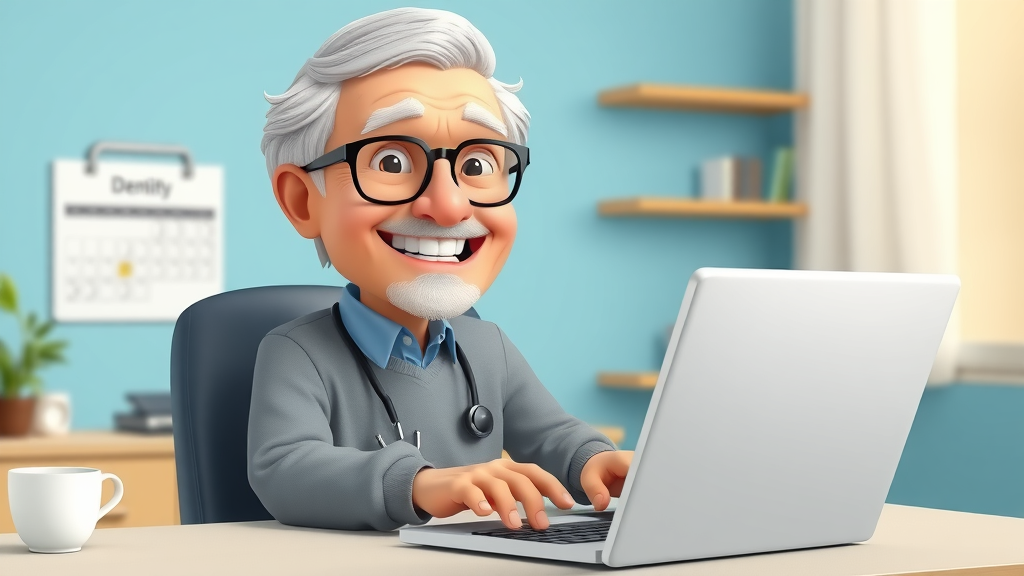Ever wondered, "Am I too old for braces or Invisalign?" Think again! Today’s orthodontic treatments are not just for teens – more older adults are getting the smile they always wanted. In this guide, we’ll challenge the myths, reveal expert insights, and explain why age is rarely a barrier to achieving a straighter smile and better oral health.
Don’t let outdated ideas hold you back! Discover how braces and Invisalign can boost your confidence, improve dental health, and fit naturally into your lifestyle — whether you’re in your 40s, 50s, 60s, or beyond.
Are You Wondering: Am I Too Old For Braces or Invisalign? Challenging the Myths for Older Adults
The question “am I too old for braces or Invisalign?” is incredibly common among older adults searching for a straighter smile. The good news: there’s no real age limit for orthodontic treatment . Many patients in their 40s, 50s, 60s, and even 70s decide it’s time to correct crooked teeth, crowded bites, or old alignment issues they’ve disliked for years.
While it’s true that younger patients might experience slightly quicker tooth movement due to softer bone tissue, that doesn’t mean older adults can’t achieve excellent results. Orthodontic advances — including braces for adults , clear aligners, and Invisalign treatment — are designed for safe, predictable outcomes at any age. Plus, boosting oral health and self-confidence is just as important for adults and seniors as it is for teens! The main considerations are oral health, bone density, and gum health — not your number of birthdays.
Let’s debunk that “age limit” myth once and for all: if your gums are healthy and you’re committed to good oral hygiene, you can straighten your teeth and enjoy the full benefits of orthodontic treatment. Join the thousands of older adult patients already enjoying aligned teeth, improved function, and the joy of smiling with confidence.

-
The real age limits for orthodontic treatment
-
The unique benefits and challenges for older adults
-
Side-by-side comparison of Invisalign, metal braces, and clear aligners
-
What makes a good candidate regardless of age
-
Straight answers from dental experts
The Pros and Cons of Braces and Invisalign Treatment for Older Adults
When older adults weigh the pros and cons of braces, Invisalign, and clear aligners, the focus usually shifts to lifestyle needs, oral health, and desired results. Both treatment options offer unique advantages — and a few limitations — for people past their teens or twenties. Invisalign aligners and clear aligner therapy bring discreet, removable comfort that’s incredibly appealing if you want minimal impact on daily routines.
On the other hand, metal braces (including traditional metal brackets) are still the gold standard for correcting severe misalignment, complex jaw issues, or major bite concerns. While they’re more visible, they don’t rely on patient compliance, making them a strong choice for someone who might forget to wear aligners.
Cost, appearance, comfort, and treatment complexity all play a part in your decision. Older adults considering braces or Invisalign should talk through these factors with their orthodontist to craft a treatment plan that respects both oral health and lifestyle goals.
“There is no age limit for achieving your best smile. Orthodontic treatment is about oral health and confidence—at any age.” – Dr. L. Martinez, Orthodontist
|
|
|
|
Comparison Table: Braces vs Invisalign vs Clear Aligners For Older Adults |
|
Treatment |
Pros |
Cons |
Ideal For |
|---|---|---|---|
|
Metal Braces |
Effective for complex cases, no compliance needed |
Visible, may cause discomfort |
Older adults with severe misalignment |
|
Invisalign |
Nearly invisible, removable for good oral hygiene |
Requires self-discipline, may be costlier |
Active older adults with mild/moderate issues |
|
Clear Aligners |
Discrete, comfortable, removable |
May not treat all cases, cost varies |
Older adults seeking aesthetics and comfort |
Orthodontic Treatment Options Explained: Metal Braces, Traditional Metal, Clear Aligners, and Invisalign Treatment
With so many orthodontic treatment options available, it’s important for older adult patients to understand what each approach can offer their smile and oral health. Traditional metal braces remain widely used for good reason: they solve complicated alignment issues and are suitable for almost anyone. However, for adults who prefer subtlety and flexibility, clear aligners and Invisalign aligners offer modern, nearly invisible solutions.
Your orthodontist will assess your needs, oral health, and desired outcomes before recommending a detailed treatment plan . Factors like gum disease, existing dental work, and bone density are relevant — but almost never a dealbreaker for healthy older adults.
Both options work well for adult orthodontic patients, though each has unique strengths. Let’s dive deeper into how metal brackets and clear aligners work to create a straighter smile, no matter your age.
Traditional Metal Braces: How Metal Brackets Help Older Adults Achieve a Straighter Smile

Traditional metal braces are made up of durable metal brackets and wires that are attached by your orthodontist. They’re exceptionally effective for treating misaligned teeth , significant bite problems, and cases where clear aligners might not manage complex movement. Braces don’t rely on patient compliance the way aligners do—once installed, you don’t have to think about remembering to wear them.
For many older adults , metal braces are the best choice for challenging orthodontic needs. While some are concerned about their visibility, today’s smaller, sleeker brackets are far less bulky than in years past. Most importantly, metal braces have a proven history of helping adults achieve stunning, healthy results—regardless of age.
If you’re an older patient with severely crooked teeth, a tough bite, or a history of dental restoration, don’t rule out traditional braces. They’re powerful, affordable, and deliver predictable outcomes for people over 40, 50, or 60. Orthodontists can tailor the treatment to minimize discomfort and maximize your long-term oral health .
Clear Aligners & Invisalign Aligners: Modern Solutions in Orthodontic Treatment for Older Adults

Clear aligners and Invisalign aligners have transformed how older adults approach orthodontic treatment. These custom-made trays are virtually invisible, removable, and designed for comfortable wear throughout the day. For older adults who prefer subtle improvements and a lifestyle-friendly option, aligners are the modern favorite.
One of the biggest advantages is the ability to remove aligners for meals and brushing, making it easier to maintain good oral hygiene and prevent gum disease. Many older patients appreciate that clear aligners allow them to present themselves confidently in professional and social situations without the conspicuous look of metal brackets.
However, successful Invisalign treatment depends on consistent wear—usually 20-22 hours a day. It’s best suited for older adults seeking minor to moderate corrections and who are committed to following their provider’s instructions closely. If you value discretion and gentle progress toward a beautifully aligned smile, clear aligner therapy can be an outstanding choice as an older adult.
Comparing Metal Braces and Clear Aligners for Your Oral Health and Confidence
When choosing between metal braces and clear aligners , think about your desired outcome and lifestyle needs. Metal braces remain the best for more severe cases, providing reliable force and comprehensive correction even if you never think about them day-to-day. In contrast, clear aligners appeal to those who want a less noticeable approach and flexibility when eating or caring for their teeth.
Both options boost confidence and oral health when used as part of a customized treatment plan . If you’re worried about gum disease or bone loss associated with age, know that orthodontists carefully screen for these concerns and can recommend the safest, most effective approach. The great news: no matter which you choose, you can achieve a straighter smile and protect your long-term dental health as an older adult.
Unsure which path is best? Ask your orthodontist which option matches your lifestyle, existing dental work, and desired pace for change. Adult orthodontic care is all about individualized, patient-centered results.
Key Considerations for Orthodontic Treatment in Older Adults: Oral Health, Bone Density, and More
If you’re considering braces or Invisalign treatment as an older adult, certain health factors deserve attention. Good oral health , stable bone structure, and management of any existing dental work are crucial. Older orthodontic patients must discuss their medical and dental history with a qualified provider to ensure optimal results and minimal risk.
It’s also important to recognize that while orthodontic treatment may progress slightly slower for adults due to reduced bone flexibility, the end results are just as transformational—and often more appreciated. Even if you’ve experienced gum disease or have dental implants, you may still be a good candidate with proper evaluation and oral care.
Factors like regular dental hygiene, the presence of bridges or crowns, and ongoing care for conditions like dry mouth or osteoporosis are all factored into your orthodontic plan. Today’s advanced imaging and planning tools help providers deliver safe, personalized results for every age.
Why Good Oral Health Matters for Braces or Invisalign After 40, 50, or 60
Maintaining good oral health is vital before, during, and after orthodontic treatment — especially for patients over 40. Healthy gums and stable bone tissue are essential foundations for shifting teeth. Your orthodontist will assess for untreated gum disease, cavities, or significant bone loss before recommending braces for adults or Invisalign aligners .
Brushing and flossing become even more important when you’re wearing braces or aligners, as older adults have a higher risk of gum recession and dry mouth. Fortunately, clear aligner systems make daily oral hygiene routines much easier, as trays are removed for cleaning. Whether you choose trays or metal brackets, prioritize your gum health and work closely with your provider!
How Age Affects Orthodontic Treatment: Myths and Facts About the Age Limit

There’s a persistent myth that there’s an age limit for orthodontic treatment, or that braces are only for teenagers. The fact is, adult patients and older adults can achieve excellent results as long as their dental foundation is healthy. In some cases, treatment may require a bit more patience as bone remodeling is less rapid than in youth.
Advancements in techniques and materials mean even patients in their seventies — or beyond! — can move teeth safely and efficiently. Age itself isn’t a barrier. Instead, oral health, gum disease management, and a long-term treatment plan are the key factors.
“Braces as an adult” or opting for clear aligners can dramatically improve not just your appearance, but also your dental function and overall quality of life. If you’ve been told you’re too old to straighten your teeth, seek a second opinion. Most orthodontic patients are delighted to discover that it’s virtually never “too late.”
Am I Too Old for Braces or Invisalign? Success Stories from Older Adult Patients
Real-life stories inspire confidence. Every year, thousands of older adults embark on the journey toward an improved smile. Some waited until after retirement, some after seeing grandchildren get braces, and some simply decided it was finally “their turn.” The results? Renewed self-image, easier eating, and often, better overall health.
Older patients often state that the benefits go far beyond appearances. A straighter smile can reduce jaw pain, aid in better cleaning and reduce the risk of gum disease. Many adults find their orthodontic journey rekindles a sense of pride in self-care and wellness that lasts for years.
“At 65, I finally got the straighter smile I always wanted. It’s never too late!” – Barbara T., actual patient
What Makes Braces or Invisalign a Good Choice For Adults?
-
Boost in self-confidence
-
Better oral health
-
Improved dental function
-
Prevention of future issues

No matter your age, well-aligned teeth are easier to keep clean and less susceptible to decay, gum disease, and excessive wear. Many older adults report that after orthodontic treatment, they’re motivated to maintain excellent oral hygiene and schedule regular checkups.
In addition, addressing misaligned teeth can prevent discomfort, headaches, and difficulty eating — all challenges that increase with age. If you’ve been holding back due to doubts about your age, know that your health, happiness, and function can benefit from braces or Invisalign. The choice is truly an investment in lifelong wellness.
People Also Ask: Common Questions About Age, Braces, and Invisalign Treatment
What age is too late for Invisalign?
There is no upper age limit for Invisalign. Adults and seniors can enjoy successful results with proper diagnosis and oral health. Your candidacy depends more on your current dental health than your age. Many older adults achieve beautiful, aligned teeth with Invisalign treatment, even starting well into their seventies.
Are braces or Invisalign better for older adults?
It depends on your specific case. Invisalign suits those seeking discretion and a removable option, especially if their main concerns are mild to moderate alignment issues. Meanwhile, traditional metal braces are preferred for older adults who require more complex tooth movements or have significant bite problems. Your orthodontist can help decide which method will deliver the safest and most effective results for your smile and oral health.
At what age is it too late to get braces?
With healthy gums and bone structure, there is no cutoff age for braces. Adults can benefit from orthodontic treatment at any stage of life. Braces help achieve a straighter smile, improve dental function, and boost confidence, regardless of when you start. Many orthodontic patients begin treatment after 40, 50, or 60 — and see tremendous benefits.
Is 72 too old to get braces?
No! Dentists and orthodontists regularly treat patients in their seventies and beyond. The most important factor is your overall dental health, not your age. As long as your gums and bone are healthy, you can enjoy all the benefits of modern orthodontic care.
Frequently Asked Questions About Braces, Invisalign, and Orthodontic Treatment for Older Adults
-
Can dental implants or missing teeth affect eligibility?
-
Will treatment time be longer for older adults?
-
What are the risks and benefits of clear aligner therapy at an advanced age?
-
How do I maintain good oral hygiene during treatment?
Your orthodontic provider will address these questions with you personally. Most obstacles can be overcome with a personalized plan, good oral hygiene habits, and collaboration with your general dentist. Don’t hesitate to seek a consultation if you have specific concerns about your dental situation.
Straightforward Steps: How to Start Your Orthodontic Treatment and Achieve a Straighter Smile

-
Schedule a professional consultation for an assessment
-
Discuss all orthodontic treatment options
-
Review costs, pros and cons, and your personal health factors
-
Begin treatment with a trusted provider
-
Maintain regular dental checkups for good oral health
Each step is designed to ensure safety, effective results, and your full understanding of the process. Starting is simpler than you think — and your journey to a straighter smile can begin today!
Expert Tips: Maintaining Good Oral Health With Braces or Invisalign for Older Adults
-
Brush and floss after every meal
-
Keep aligners and metal brackets clean
-
Use fluoride and antimicrobial rinses
-
Visit your orthodontist regularly
Prioritize oral hygiene by cleaning your teeth and orthodontic appliances thoroughly. Proper care limits gum disease and helps maintain beautiful results. Schedule regular cleanings and exams — your smile will thank you for years to come!
Key Takeaways: Am I Too Old For Braces or Invisalign? What Older Adults Should Remember
-
Age is rarely a barrier to orthodontic treatment
-
Both metal braces and Invisalign offer unique benefits for older adults
-
Prioritizing oral health sets the stage for stunning results
-
Seek an experienced orthodontist for an individualized plan
Ready for a Straighter Smile? Subscribe Now for More Orthodontic Guides and Updates
Subscribe now to get the latest Grand Strand orthodontic guides, tips, and updates — right to your inbox. No spam. Just smiles.
Age is not a barrier to achieving a straighter smile with braces or Invisalign. Many adults, even into their 70s and 80s, successfully undergo orthodontic treatment. As long as your teeth and gums are healthy, you can benefit from these treatments at any age. ( health.osu.edu )
Invisalign offers a discreet and convenient option for adults seeking to improve their dental alignment. The clear aligners are nearly invisible and can be removed for eating and oral hygiene, making them a popular choice among adults and seniors. ( enhanceorthodonticsmi.com )
However, certain dental conditions, such as severe misalignment or existing dental work like bridges or implants, may affect your suitability for Invisalign. It’s essential to consult with an orthodontist to determine the best treatment plan for your specific needs. ( evpdental.com.au )
In summary, you’re never too old for braces or Invisalign. With healthy teeth and gums, orthodontic treatment can enhance your smile and oral health at any stage of life.
 Add Row
Add Row  Add
Add 




Write A Comment